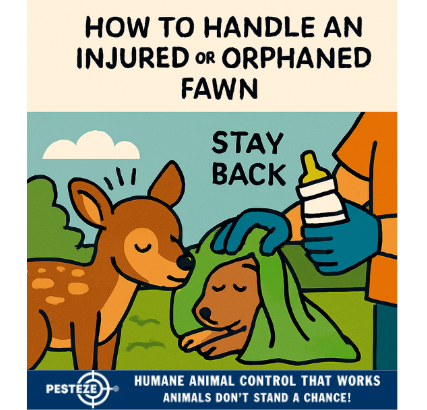HOW TO HANDLE AN INJURED OR ORPHANED FAWN

HOW TO HANDLE AN INJURED OR ORPHANED FAWN
SUMMARY
Finding an injured or orphaned fawn can be a heart-wrenching experience, but human intervention isn’t always the right answer. Many fawns are mistakenly thought to be abandoned when they’re actually safe and waiting for their mother. This guide helps you assess the situation, take appropriate action, and contact the right professionals. With compassion and caution, you can support wildlife without disrupting nature’s balance.
FEATURES
-
Assess Before Acting: Learn how to determine if the fawn truly needs help.
-
Signs of Injury or Distress: Identify physical symptoms that require immediate attention.
-
Avoid Human Scent Transfer: Use gloves or tools to prevent maternal rejection.
-
Do Not Attempt Feeding: Understand why feeding can harm more than help.
-
Contact Wildlife Experts: Know when and how to reach licensed rehabilitators.
-
Legal and Ethical Guidelines: Follow state laws and humane practices for wildlife care.
GUIDE DESCRIPTION
Spotting a fawn alone in the wild often triggers concern, but not every solitary fawn is orphaned. This guide provides essential steps to help you respond appropriately and legally when encountering a fawn that appears injured or abandoned.
Start by observing from a distance. Fawns are frequently left alone while their mothers forage nearby. If the fawn is lying quietly, appears clean, and shows no signs of distress, it’s likely not in danger. Intervening unnecessarily can cause more harm than good.
However, if the fawn is visibly injured—limping, bleeding, crying out, or covered in flies—it may need help. In such cases, avoid touching the animal directly. Use gloves or a clean cloth to minimize scent transfer, which can lead to maternal rejection if the mother returns.
Never attempt to feed the fawn. Their digestive systems are delicate, and improper feeding can cause illness or death. Instead, focus on keeping the area quiet and secure while you contact a licensed wildlife rehabilitator. These professionals are trained to assess and care for injured or orphaned animals properly.
Each state has specific laws regarding wildlife handling. In many areas, it’s illegal to keep or transport wild animals without a permit. Always follow local regulations and avoid taking matters into your own hands.
If the fawn is in immediate danger—such as near a busy road or in a predator-prone area—gently guide it to a safer spot nearby, but only if absolutely necessary and without prolonged contact.
By acting responsibly and seeking expert help, you’ll give the fawn the best chance of survival while respecting wildlife laws and natural processes.
- Amy Chang


Comments 0